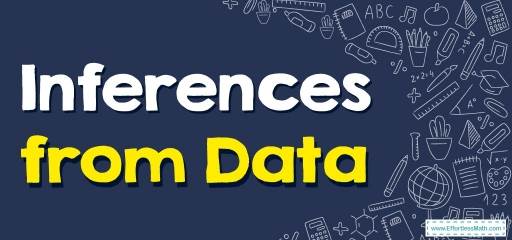How to Make Inferences from Data? (+FREE Worksheet!)

In this article, you will learn how to make inferences from data in a few simple steps.
Step by step guide to Make Inferences from Data
In the research process, after collecting data, the next step involves analyzing the data. The statistical analysis process helps the researcher to extract the required information from the initial data and to generalize the results if necessary. Analyzing information as part of the process of the scientific research method is one of the basic foundations of any study and research. The first step you need to do after collecting data is to review and process the collected data so that you can apply statistical analysis to it.
To inference data the following steps should be taken:
- Organize data and order from least to greatest.
- Then find the least and greatest values, the median and the lower and upper quartiles.
- Calculate the upper and lower quartile by medians of each “half” of the number line that includes all the data.
- Then you should draw a number line that includes all the data values
- In the next step, you should plot a point for each of the values found.
- From the lower to upper quartile, draw a box. Inside the box, draw a vertical line through the median.
- In the last step, you should draw the whiskers by connecting the least and greatest values to the box.
Median: This statistical index shows the value that is in the middle of the data. It is known that \(50%\) of the data is smaller or larger than this value. This indicator is drawn by a vertical line inside the box.
Lower Quartile \(Q1\): This indicator shows a value that is \(25%\) smaller than the data. On the other hand, this value can be considered as the middle of the data that are between the smallest value and the middle. This value is formed by a vertical line on the left side of the box.
Upper Quartile \(Q3\): This indicator shows a value that is \(75%\) of data is smaller than this value. On the other hand, this value can be considered as the middle of the data that is between the largest value and the middle. the indicator is made by a vertical line on the right side of the box.
Intermediate-range \(IQR\): The distance between the lower and upper Quartile is indicated by this index. The length of the other sides of the box is determined by this indicator.
whiskers: These lines fill the space between the lower Quartile and the minimum value as well as the maximum value.
Making Inferences from Data Example 1:
The number of pets owned by a random sample of students at park middle school is shown below. Use data to make a box plot. How many pets does every student have?
\(2, 4, 1, 5, 9, 4, 2, 11, 6\)
Solution: order the data from least to greatest. \(1, 2, 2, 4, 4, 5, 6, 9, 11\)
Then find the least and greatest values, the median and the lower and upper quartiles. The lower and upper quartiles can be calculated by finding the medians of each “half” of the number line that includes all the data. Draw a number line that includes all the data values. Plot a point for each of the values found.
Draw a box from the lower to upper quartile. Inside the box, draw a vertical line through the median. Finally, draw the whiskers by connecting the least and greatest values to the box.

Almost every student has at least 1 pet.
Making Inferences from Data Example 2:
Jack collected a random sample of 130 women regarding woman’s color bag preference for his new bag business. Make an inference from the data.
| Sample | Black Bag | Green Bag | Blue Bag | Total |
| #1 | 29 | 27 | 74 | 130 |
Solution: Inference: According to the table above, most people prefer Blue bags.
Exercises for Making Inferences from Data
Answer the following problems.
1) Draw a box plot for the data set: {\(1, 6, 9, 2, 6, 6, 5, 8, 1, 9 , 4\)}
2) Management wants to open a cafeteria in the office building. So they collected data from a random sample of 50 employees regarding employee’s office lunch preference? Make at least two inferences based on the result.
| Sample | Cheesesteak | Corn Dog | Sandwich | Total |
| #1 | 25 | 12 | 63 | 100 |
3) Use the given data to make a box plot. {\(14, 5, 15, 7, 8, 11, 13, 14, 6\)}

1)

2) Most employees prefer Sandwich.
Corn Dog is not very popular
3)

Related to This Article
More math articles
- FREE 5th Grade STAAR Math Practice Test
- 8th Grade DCAS Math Worksheets: FREE & Printable
- Best Laptop for Math Students In 2024
- How to Scale a Function Horizontally?
- 9 Best Math Websites for Teachers and Students
- How to Identify Real Numbers
- How to Apply for College: Complete Guide
- Why Do I Need MATLAB Assignments Experts Help and Where One Get It
- FREE TASC Math Practice Test
- Improving Your Math in College: What You Should Do


















What people say about "How to Make Inferences from Data? (+FREE Worksheet!) - Effortless Math: We Help Students Learn to LOVE Mathematics"?
No one replied yet.